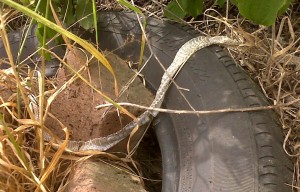It’s been a while since the local ponies were on the site when I was around, but last week (June 23rd) I was intently studying the spread of the rare Brookweed when there was a quiet rustling right behind me. The culprit was this piebald specimen. Whilst these animals are fairly free-ranging across a large part of Stanham Farm, they’re tame enough that they’ll carry on grazing normally whilst being watched closely. Although it was eating around patches of Brookweed, it didn’t touch them – in fact the rabbits must leave it alone as well or there would be little if any of it left. This selective grazing, and trampling to produce a bare mud seed bed, has the conservation benefit of sustaining this plant on the site. ‘Conservation grazing’ through the reintroduction of large herbivores or, where extinct, their domesticated descendants is, of course, being deliberately used on much larger projects, such as those of ‘Rewilding Europe’. What it did have a chomp on was an immature Reedmace seed head, so I broke off and handed it some more as it didn’t seem to realise it could get at further supplies by trampling down some of the plants itself.
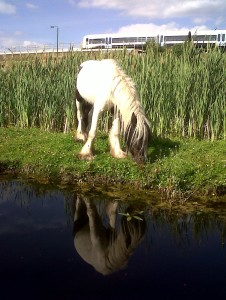
Conservation grazing in action – a pony grazes around a stand of Brookweed at Thames Road Wetland. This is a very rare plant in London that benefits from trampled mud and removal of the more vigorous competing plants around it by the local ponies. (Photo: Chris Rose)
That brings me on the fact that there are two species of Reedmace in the UK. Greater Reedmace or ‘Bulrush’ (Typha latifolia) and Lesser Reedmace (Typha angustifolia). Both occur at Thames Road Wetland, though the former – as in most places – in much greater profusion. They can be told apart by plant habit and leaf width, but when in flower the former has no gap between the clusters of male and female flowers, whilst the latter does have one, as illustrated in the photos below. They can hybridise.
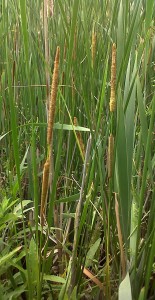
Lesser Reedmace – note distinct gap between the male flower cluster at the top and the female below. (Photo: Chris Rose)
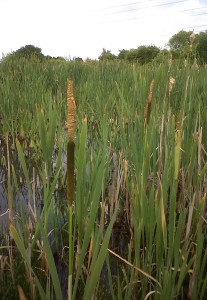
Greater Reedmace has a ‘waist’ between the tan coloured male flowers at the top and dark brown female ones below, but no gap. (Photo: Chris Rose)
It was quiet on the bird front. Apart from the chuntering of Reed Warblers, there was a greenfinch calling and a Cetti’s Warbler. Goldfinches and a Song Thrush were heard. 5 Swifts were flying overhead. A male Reed Bunting was calling on Stanham Farm, and may have been the same bird that was on Thames Road Wetland recently.
Lepidoptera seen were single Small Tortoiseshell, Comma, Small White and Common Blue, plus Essex Skippers and Cinnabar Moths. Azure Damselflies, a female Banded Demoiselle, and a Broad-bodied Chaser Dragonfly were noted. A small Bryony Ladybird larva was found within the bowl of the site.
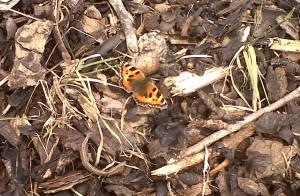
A fresh Small Tortoiseshell at Thames Road Wetland, the lower Cray area being one of the best places to see this insect which has declined significantly but now appears to be making a slow recovery. (Photo: Chris Rose)
Despite the heat a couple of Common Lizards were seen, and this cast Grass Snake skin was noticed draped over a ‘basking tyre’. It was collected to send off to a genetics project looking at possible fragmentation and inbreeding problems with UK snake populations.
The effects of the ongoing lack of rainfall were very evident on the flat area by Thames Road itself, which is compacted gravelly material used to widen the embankment. Most of the nectar plants were no longer in flower, and the two species of Melilot that grow here were not in evidence.
Some work was done on informal paths ahead of the Qwaggy Waterways Action Group visit in mid July, various bits of litter were removed and some more Marsh Sow-thistles were planted.
Chris Rose. Thames21 Volunteer Site Manager.

